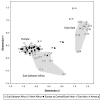Worldwide distribution of NAT2 diversity: implications for NAT2 evolutionary history
- PMID: 18304320
- PMCID: PMC2292740
- DOI: 10.1186/1471-2156-9-21
Worldwide distribution of NAT2 diversity: implications for NAT2 evolutionary history
Abstract
Background: The N-acetyltransferase 2 (NAT2) gene plays a crucial role in the metabolism of many drugs and xenobiotics. As it represents a likely target of population-specific selection pressures, we fully sequenced the NAT2 coding region in 97 Mandenka individuals from Senegal, and compared these sequences to extant data on other African populations. The Mandenka data were further included in a worldwide dataset composed of 41 published population samples (6,727 individuals) from four continental regions that were adequately genotyped for all common NAT2 variants so as to provide further insights into the worldwide haplotype diversity and population structure at NAT2.
Results: The sequencing analysis of the NAT2 gene in the Mandenka sample revealed twelve polymorphic sites in the coding exon (two of which are newly identified mutations, C345T and C638T), defining 16 haplotypes. High diversity and no molecular signal of departure from neutrality were observed in this West African sample. On the basis of the worldwide genotyping survey dataset, we found a strong genetic structure differentiating East Asians from both Europeans and sub-Saharan Africans. This pattern could result from region- or population-specific selective pressures acting at this locus, as further suggested in the HapMap data by extremely high values of FST for a few SNPs positions in the NAT2 coding exon (T341C, C481T and A803G) in comparison to the empirical distribution of FST values accross the whole 400-kb region of the NAT gene family.
Conclusion: Patterns of sequence variation at NAT2 are consistent with selective neutrality in all sub-Saharan African populations investigated, whereas the high level of population differentiation between Europeans and East Asians inferred from SNPs could suggest population-specific selective pressures acting at this locus, probably caused by differences in diet or exposure to other environmental signals.
Figures



References
-
- Hein DW. Molecular genetics and function of NAT1 and NAT2: role in aromatic amine metabolism and carcinogenesis. Mutat Res. 2002;506:65–77. - PubMed
Publication types
MeSH terms
Substances
LinkOut - more resources
Full Text Sources
Other Literature Sources
Molecular Biology Databases
Research Materials
Miscellaneous

